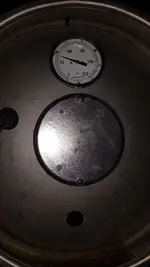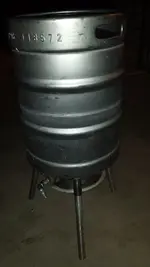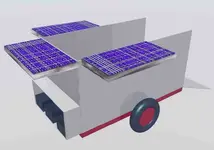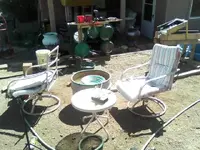Well it's been awhile since I posted anything here but that doesn't mean I've been idle. We haven't had a chance to get back out to the claim since the last trip but I have been busy. Lately I've been spending a LOT of time learning more on mining law in an effort to protect our investment. I've also been running some experiments to figure out the best way to process the materials from our claim. Here is what I've learned so far and how I went about doing these experiments.....

Using some of the black sands I had built up I weighed out 200 gram samples. Each of these samples had had all of the magnetic materials removed form them and had also been through the Shake & Bake process once already. Using my coffee grinder I worked the sands down to as fine as I could get them and then I crushed them even more using a large bearing I had found. I then ran the materials through a nylon stocking (don't have a really fine screen yet) and then went through them with a magnet once again. Even though I couldn't pick up any magnetic sands before grinding, I ended up pulling an average of 40 grams of magnetics out of each sample.

The grinding process also released a lot of what looks like rust powder. I carefully rinsed the materials to remove this powder and then put them on the heat. I brought the temperature of each sample up to 450 degrees and then quenched the sands in ice water. Even though they had been through the S&B process before, I found even more gold in each and every sample.

Some of the pieces were large enough to be seen with the naked eye while many of them I had to use a strong magnifying glass to be able to spot them. This stuff made "Flour Gold" look big it was so fine. There was actually quite a bit of this "Micro-flour" in each sample.
After tapping the fine gold to one edge of the pan as best as I could, I added a large drop of mercury and worked it carefully through the materials. After this I sucked the mercury out of the pan and put the amalgam into a separate container so it wasn't being mixed into my clean mercury supply. (still plenty of room left in the mercury to grab more gold out later) I then re-examined the materials with the magnifier and couldn't see any of the super fine gold in it any more so it seems that the mercury had done its job. (NOTE: As a trained lab tech I know how to handle dangerous materials like Mercury in a safe manner.

This is not something that someone without proper training should attempt at home!!!

)
So... What did I learn from these experiments?
1. Before doing a Shake & Bake the sands should be ground as fine as possible. To make this process easier and less time consuming in the future I will be picking up a small Ball Mill that has a 15 pound capacity. The grinding will not only help to remove any oxide clinging to the small gold but many of the pieces that I couldn't see before are flattened out which gives them more surface area so they can be spotted much easier. Particles of black sands will crush while gold will merely flatten out because of its malleability. The grinding will also help to break up any left over magnetic materials so they can be removed with ease.
2. Doing amalgamation in a pan is a slow process and you can only do a little bit at a time. To make this easier I'm also going to pick up a 6 pound capacity tumbler that has dual 3 pound drums. This will allow me to do this stage of the processing in larger batches than I can do in a pan with a much higher margin of safety.

3. All quenching of the heated materials will be done using a mixture of vinegar and salt (sodium acetate) which will not only crack the oxide off the gold due to the rapid temperature change but will also help to shine up the gold making it easier to see. Vinegar and salt is not expensive and is easy to get. It can also be recycled and used several times as long as it's cooled back down.
I've been searching on-line for the required equipment for this change of processing the black sands and have found everything I need for this re-tooling will run me less than $500. With the amount of gold I found just in these experiments I feel that the purchase cost will be recovered after running only a dozen or so batches so it's well worth the investment in my mind.
My new method of processing materials will be as follows from now on:
1. Dig and classify the raw materials.
2. Sluice the materials down.
3. Pan the cons, remove what magnetic materials I can and get the visible gold out
4. Grind the remaining materials in the Ball Mill until they're down to 200 mesh.
5. Remove any magnetic sands and rinse out the "rust dust" that comes from the grinding process.
6. Shake & Bake using vinegar and salt for the quench.
7. Amalgamate the gold out of the sands and recover both gold and mercury using proper safety measures.
8. Repeat as often as possible.....
This process seems to me to be the least time consuming way to get as much of the gold out of our materials as possible. I know that most likely I'll still be missing some small amount of gold, but that little bit that gets away isn't going to be worth the cost of recovering it in my mind. This procedure should prove to be both quick as well as cost effective.
I’m sharing these results with everyone so they won’t have to reinvent the wheel to learn the same things. Keep in mind though that every area is different in its composition so there may or may not be recoverable amounts of micro fine gold in your materials.







 Talk about your big screen!
Talk about your big screen!



 The grinding process also released a lot of what looks like rust powder. I carefully rinsed the materials to remove this powder and then put them on the heat. I brought the temperature of each sample up to 450 degrees and then quenched the sands in ice water. Even though they had been through the S&B process before, I found even more gold in each and every sample.
The grinding process also released a lot of what looks like rust powder. I carefully rinsed the materials to remove this powder and then put them on the heat. I brought the temperature of each sample up to 450 degrees and then quenched the sands in ice water. Even though they had been through the S&B process before, I found even more gold in each and every sample.  This is not something that someone without proper training should attempt at home!!!
This is not something that someone without proper training should attempt at home!!! 



